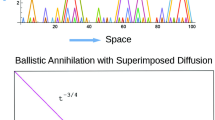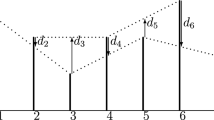Abstract
We consider ballistic annihilation, a model for chemical reactions first introduced in the 1980’s physics literature. In this particle system, initial locations are given by a renewal process on the line, motions are ballistic—i.e. each particle is assigned a constant velocity, chosen independently and with identical distribution—and collisions between pairs of particles result in mutual annihilation. We focus on the case when the velocities are symmetrically distributed among three values, i.e. particles either remain static (with given probability p) or move at constant velocity uniformly chosen among \(\pm 1\). We establish that this model goes through a phase transition at \(p_c=1/4\) between a subcritical regime where every particle eventually annihilates, and a supercritical regime where a positive density of static particles is never hit, confirming 1990s predictions of Droz et al. (Phys Rev E 51(6):5541–5548, 1995) for the particular case of a Poisson process. Our result encompasses cases where triple collisions can happen; these are resolved by annihilation of one static and one randomly chosen moving particle. Our arguments, of combinatorial nature, show that, although the model is not completely solvable, certain large scale features can be explicitly computed, and are universal, i.e. insensitive to the distribution of the initial point process. In particular, in the critical and subcritical regimes, the asymptotics of the time decay of the densities of each type of particle is universal (among exponentially integrable interdistance distributions) and, in the supercritical regime, the distribution of the “skyline” process, i.e. the process restricted to the last particles to ever visit a location, has a universal description. We also prove that the alternative model introduced in [7], where triple collisions resolve by mutual annihilation of the three particles involved, does not share the same universality as our model, and find numerical bounds on its critical probability.




Similar content being viewed by others
References
Arratia, R.: Site recurrence for annihilating random walks on \({\mathbf{Z}}_d\). Ann. Probab. 11(3), 706–713 (1983)
Belitsky, V., Ferrari, P.A.: Ballistic annihilation and deterministic surface growth. J. Stat. Phys. 80(3–4), 517–543 (1995)
Ben-Naim, E., Redner, S., Leyvraz, F.: Decay kinetics of ballistic annihilation. Phys. Rev. Lett. 70(12), 1890–1893 (1993)
Benitez, L., Junge, M., Lyu, H., Redman, M., Reeves, L.: Three-velocity coalescing ballistic annihilation. arXiv preprint arXiv:2010.15855, (2020)
Bramson, M., Lebowitz, J.L.: Asymptotic behavior of densities for two-particle annihilating random walks. J. Stat. Phys. 62(1–2), 297–372 (1991)
Broutin, N., Marckert, J.-F.: The combinatorics of the colliding bullets. Random Struct. Algor. 56(2), 401–431 (2020)
Burdinski, D., Gupta, S., Junge, M.: The upper threshold in ballistic annihilation. ALEA Lat. Am. J. Probab. Math. Stat. 16(2), 1077–1087 (2019)
Canfield, E.R.: Remarks on an asymptotic method in combinatorics. J. Combin. Theory Series A 37(11), 348–352 (1984)
Denisov, D., Dieker, A.B., Shneer, V.: Large deviations for random walks under subexponentiality: the big-jump domain. Ann. Probab. 36(5), 1946–1991 (2008)
Droz, M., Rey, P.-A., Frachebourg, L., Piasecki, J.: Ballistic-annihilation kinetics for a multivelocity one-dimensional ideal gas. Phys. Rev. E 51(6), 5541–5548 (1995)
Dygert, B., Kinzel, C., Junge, M., Raymond, A., Slivken, E., Zhu, J.: The bullet problem with discrete speeds. Electron. Commun. Probab. 24(27), 11 (2019)
Elskens, Y., Frisch, H.L.: Annihilation kinetics in the one-dimensional ideal gas. Phys. Rev. A 31(6), 3812–3816 (1985)
Ermakov, A., Tóth, B., Werner, W.: On some annihilating and coalescing systems. J. Stat. Phys. 91(5), 845–870 (1998)
Flajolet, P., Sedgewick, R.: Analytic Combinatorics. Cambridge University Press, Cambridge (2009)
Grimmett, G.: Percolation. Springer-Verlag, Berlin (1989)
Haslegrave, J., Tournier, L.: Combinatorial universality in three-speed ballistic annihilation. In In and Out of Equilibrium 3: Celebrating Vladas Sidoravicius. Springer (2021). (Progress in Probability 77)
Junge, M., Lyu, H.: The phase structure of asymmetric ballistic annihilation. arXiv preprint arXiv:1811.08378, (2018)
Kleber, M., Wilson, D.: “Ponder This” IBM research challenge. https://www.research.ibm.com/haifa/ponderthis/challenges/May2014.html, May (2014)
Kovchegov, Y., Zaliapin, I.: Dynamical pruning of rooted trees with applications to 1-d ballistic annihilation. J. Stat. Phys. 181(2), 618–672 (2020)
Krapivsky, P.L., Redner, S., Leyvraz, F.: Ballistic annihilation kinetics: The case of discrete velocity distributions. Phys. Rev. E 51(5), 3977–3987 (1995)
Krug, J., Spohn, H.: Universality classes for deterministic surface growth. Phys. Rev. A 38(8), 4271–4283 (1988)
Nagaev, S.V.: On the asymptotic behaviour of one-sided large deviation probabilities. Teoriya Veroyatnostei i ee Primeneniya 26(2), 369–372 (1981)
Sidoravicius, V., Tournier, L.: Note on a one-dimensional system of annihilating particles. Electron. Commun. Probab. 22(59), 9 (2017)
Siegel, C.: Topics in Complex Function Theory, Vol. I: Elliptic Functions and Uniformization Theory. Wiley Interscience (1969)
Trizac, E.: Kinetics and scaling in ballistic annihilation. Phys. Rev. Lett. 88(16), 160601 (2002)
Acknowledgements
J.H. has been supported by the European Research Council (ERC) under the European Union’s Horizon 2020 research and innovation programme (grant agreement no. 639046) and by the UK Research and Innovation Future Leaders Fellowship MR/S016325/1, and is grateful to Agelos Georgakopoulos for several helpful discussions. L.T. was supported by the French ANR project MALIN (ANR-16-CE93-000).
Author information
Authors and Affiliations
Corresponding author
Additional information
Publisher's Note
Springer Nature remains neutral with regard to jurisdictional claims in published maps and institutional affiliations.
To the dear memory of Vladas Sidoravicius, who untimely passed away during the final preparation of this paper.
Rights and permissions
About this article
Cite this article
Haslegrave, J., Sidoravicius, V. & Tournier, L. Three-speed ballistic annihilation: phase transition and universality. Sel. Math. New Ser. 27, 84 (2021). https://doi.org/10.1007/s00029-021-00701-x
Accepted:
Published:
DOI: https://doi.org/10.1007/s00029-021-00701-x




